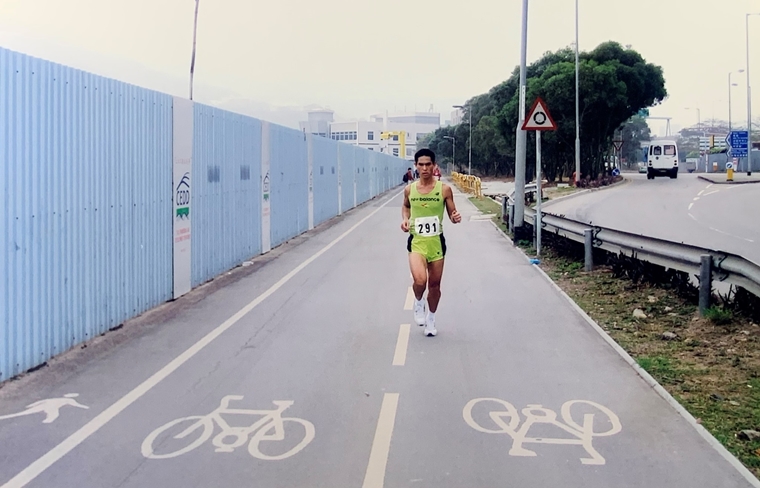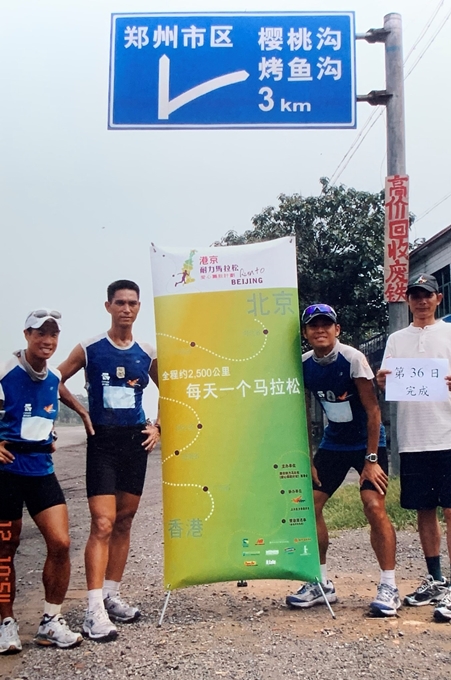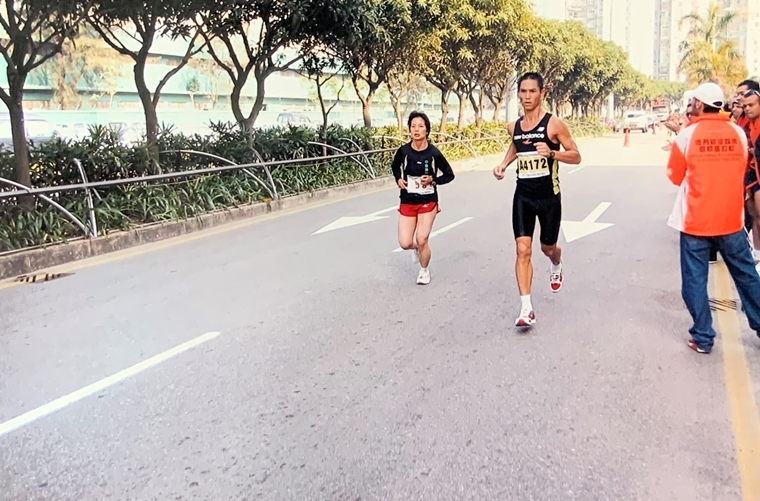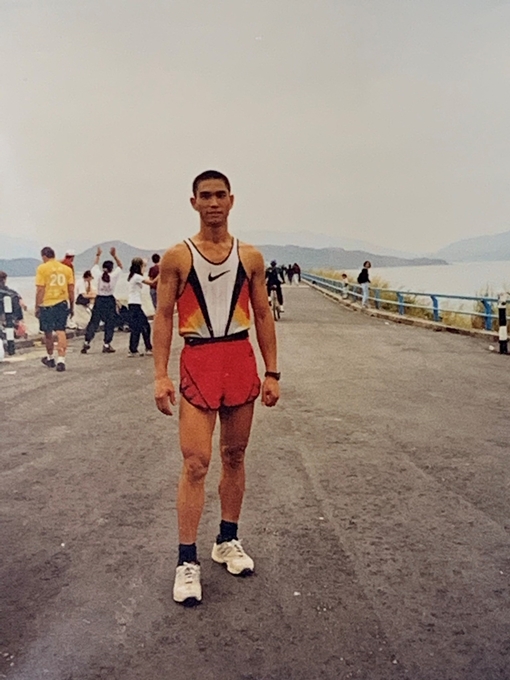
每當提起 KK Chan,不少人第一時間便會想起「毅行先生」和「越野」。然而,他的身影卻絕不止於山野之間。香港、澳門、廈門、北京、蒙古、南韓、美國、撒哈拉等,KK 的足跡早已遍佈於世界各地的馬拉松路徑上,當中更不乏全長超過42公里的超級馬拉松。2015至18年間,他亦曾主辦過三次超級馬拉松,更於2016年創下「10人24小時最長跑步總距離」的世界紀錄。
提到 KK 由山野轉戰到公路的原因,就要追溯到1997年。話說 KK 與隊友參與當年的毅行者後,有感於自身的實力不足,於是想法設法加強鍛鍊。其時 KK 在隊友的推薦下,首次接觸馬拉松賽事。該年的比賽為「港深耐力馬拉松」,而 KK 亦以3小時56分順利完賽。本以為比起動輒以10小時起計的毅行者比賽而言,馬拉松比賽會輕鬆得多,然而事後 KK 卻認為該次馬拉松比毅行者更為辛苦。箇中的原因,就在於越野賽與公路賽的「腳感」之別。
據 KK 解釋,所謂的「腳感」,是指跑手行走於高低斜坡、浮砂碎石、乾濕路段等不同地面狀況時,腳部依靠肌肉記憶而作出的步伐調整。簡而言之,腳感較佳的跑手會懂得適應不同的路段,同時保持原有的速度繼續前進。越野賽的「腳感」主要體現於高低錯落、崎嶇不平的山路之上,而公路賽的「腳感」就在於如何適應長時間在平緩的路面上保持均衡步速。
問及 KK 會否建議越野跑手參與馬拉松,他表示絕對支持。皆因越野跑手時常於山野間訓練,體能上已有一定的根柢,有助適應馬拉松的耐力考驗。加上馬拉松的路段以平路為主,跑手可以藉此訓練並加強在平路上的爆發力及持久力,如此對於越野賽的總成績亦大有幫助。

同時 KK 亦根據過往多年的參賽經驗,特別提醒跑手們注意「熱身」。KK 所指的「熱身」並非單止一般的伸展及拉筋,而是肌肉、血管、筋膜及關節的放鬆及加速全身的血液循環。由於亞洲地區的長跑賽事一般在較寒冷的天氣進行,簡單的拉筋及伸展未能完全將肌肉放鬆,若然起步時便卯足全力,容易導致肌肉拉傷。故此,KK 建議跑手們無論是練習或實戰時,都在首5公里的路段上放慢腳步,待身體肌肉逐漸進入狀態,血液循環加快後,才在後37公里的路段上發力,如此既能減低受傷的機會,亦能讓身體在比賽中保持最佳狀態。據 KK 觀察,不少經驗豐富的跑手均深諳此道,故特此提醒未曾參與馬拉松的跑手們。
此外,KK 亦特意提醒跑手們避免在緩步行上斜路,以及在落斜路時跨大腳步及加快速度。皆因如此將會大大增加傷患的機會。KK 認為人的意志力有限,比賽途中一但放鬆,便難以回到原本的速度。情況就如跑手們面對斜度較大的路面,容易放慢腳步,緩步走上,但往往上到平路後便難以恢復之前的步伐。因此,他建議跑手們練習慢跑 (Jogging) 上斜路,如此一到較為平緩的路段便能立即加快速度,落斜路時亦不用為追回距離而加快步伐,以致令受傷機會大增。無論如何,跑手們均需懂得保護自己的身體,這樣方能做到「長跑長有」。
撰文: Paul Chong

#ChapterNine: Wild run fun-About marathon
The name KK Chan is always related to Mr. Trailwalker and trail running. Yet, he does not only show up in the wild. He has joint marathon around the world, like Hong Kong, Macau, Xiamen, Beijing, Mongolia, South Korea, America, Sahara and so on. Some of the races were ultramarathon which are longer than 42 kilometers. From 2015 to 2018, he organized three ultramarathons and set a world record which is called “the longest total running distance of 10 persons during 24 hours“ in 2016.
----- 廣告 Ad -----
We have to return to 1997 to find out the reason why KK turned himself from trail running to road running. After KK joint trailwalker, he found that he was not fit enough and he was finding a way to improve his fitness. Being recommended by his teammate, KK tried his first time in marathon and it was “Hong Kong Shenzhen Marathon”. He finished in 3 hours 56 minutes. He thought that it was already difficult to race for at least 10 hours in trailwalker, but he was surprised that marathon was more challenging than trailwalker. The reason why road race was difficult for him because there is a difference in “feet sensitivity” between running on the trail and on the road.
According to KK, “feet sensitivity” means that feet muscle will adjust themselves with their muscle memory when runners are running upslope or downslope, on sand or stones, and on dry or wet roads. Long story short, runners with better feet sensitivity are more able to adapt to roads with different conditions while keeping the same pace. Runners will apply “feet sensitivity” in trail running mainly when they run up or down hill and on rough roads; runners apply “feet sensitivity” in road running when they have to run at a steadfast pace on a flat road for a period of time.
While being asked about whether trail runners should also join marathon, KK absolutely supported it. Trail runners have well developed their physical fitness while they have training in the wild, they have the advantage of enduring longer in marathon. It is usually flat road in marathon, runners can take the chance to train their power and endurance which can help improve the performance in trail running.
With abundant racing experience, KK emphasized the importance of “warm up” before every race. “Warm up” to him does not only mean stretching, it is about warming up muscle and blood vessels, relaxing joints and increasing the blood flow in the whole body. Most of the Asian long run races are held in cooler places, simply stretching cannot help relax all the muscle. If runners start too fast at the start of the race, their muscle will be easily hurt. Therefore, KK suggested that runners should run slowly in the first 5 kilometers no matter it is a race or a training. This practice can help awake the muscle and runners can run faster in the latter 37 kilometers after the blood flows faster. It can lower the chance of injury and help the body maintain the best condition in the race. According to KK’s observation, many experienced runners understand this and he hoped to remind those who have not tried marathon before.
Apart from that, KK stressed that runners should avoid walking, over striding or speeding up when they go upslope. Injury will be caused in those cases. KK believed that willpower of a person is limited, it is hard to get back to the original pace if the runner relaxes for a second. For example, if the runner is ready to run up the steep slope, he will slow down the pace easily but he cannot go back to the original pace when he returns to the flat road. Hence, KK suggested that runners should practise jogging up to the slope so that runners can run faster when they return to a flat road. When going downslope, there is no need to run faster because it will increase the chance of getting injured. No matter what, runners should know how to protect their bodies in an attempt to “run longer and further”.
<By Paul Chong>

